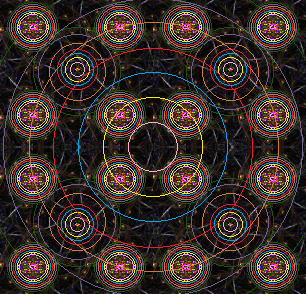Chaos And Fractal
Chaos, from the Greek "Khaos or Chaos" refers to the unpredictable; in the same way, by its "ghen" root protoindoeuropea its meaning tends to "disorder". That is to say, Chaos is a complexity of nature which tends thermodynamically to a minimum of energy and to a maximum disorder with principles of causality in the phenomenological relation that leaves no observable samples between cause and effect.
In this sense, Chaos in the Philosophical/Epistemological sphere is associated with the inability of the human being to understand and manipulate all the facts in a concrete space and at a certain moment, having to assume the proper concepts of indeterminacy, randomness, statistics and probability, as opposed to their antonyms as more natural, understandable, acceptable, and pragmatic facts. For the adaptability and survival of the human being, he must be able to dominate and modify his environment, without casuistic facts that affect him too much (for example: an earthquake); with the need to understand and "predict" Chaos in the search for order and its evolutionary stability.
On the other hand, in Physics and Mathematics, Chaos is studied based on the theory of Dynamic Systems, specifically non-periodic deterministic "chaotic behaviors", sensitive to the initial conditions; and from there was born, the famous "Theory of Chaos", considered as the "Science of Totality", since it is about determinism and indeterminism in a single system.
Therefore, for this "Chaos Theory", a dynamic system can be deterministic and indeterministic at the same time and for any discipline be scientific or humanistic (Sociology and human and mass behavior; Economics and stock exchange or inflation, medicine and heart, neural networks or fractures, engineering and fatigue of materials, among others).
In this area, it is considered that Chaos Theory can be better studied on the basis of Fractal Theory, since this is an ideal tool to analyze all the dynamic systems that happen in nature. In fact, a Fractal is a drawing or a geometric object whose basic structure is repeated at different scales, with size and variable orientation; being its minimum starting unit that generates, by multicomposition, a unit geometrically greater, therefore each stage, from the minimum to the maximum, has a similar appearance to its predecessor.
Finally, as an example of Fractal, below I present a "quasi fractal" not very well done by me, using Microsoft PaintBrush:

@eileenbeach has voted on behalf of @minnowpond.
If you would like to recieve upvotes from minnowponds team on all your posts, simply FOLLOW @minnowpond.
@royrodgers has voted on behalf of @minnowpond.
If you would like to recieve upvotes from minnowponds team on all your posts, simply FOLLOW @minnowpond.
@driva has voted on behalf of @minnowpond.
If you would like to recieve upvotes from minnowponds team on all your posts, simply FOLLOW @minnowpond.
holaaaaaaaaaaaaaaaa aqui esta mi voto
holaaaaaaaaaaaaaaaa aqui esta mi voto
As a follower of @followforupvotes this post has been randomly selected and upvoted! Enjoy your upvote and have a great day!
@OriginalWorks !originalworks
The @OriginalWorks bot has determined this post by @josevasquez to be original material and upvoted(2%) it!
To call @OriginalWorks, simply reply to any post with @originalworks or !originalworks in your message!
@minnowpond1 has voted on behalf of @minnowpond.
If you would like to recieve upvotes from minnowponds team on all your posts, simply FOLLOW @minnowpond.
@alchemage has voted on behalf of @minnowpond.
If you would like to recieve upvotes from minnowponds team on all your posts, simply FOLLOW @minnowpond.
@minnowpondred has voted on behalf of @minnowpond.
If you would like to recieve upvotes from minnowponds team on all your posts, simply FOLLOW @minnowpond.